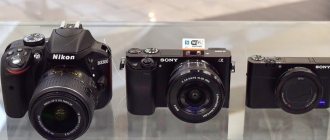The main purpose of a multimedia projector is to project images received from various video sources onto a distant surface. The principle of operation of the device is similar to the principle of operation of a conventional film projector: light rays from a powerful lamp fall on a special module in which an image is formed (in a film projector, a film frame is used for this). It then passes through the lens and projects the image onto the screen. The advantage of this video output scheme is the ability to obtain images of different diagonals. The specific image size and quality depend on the projector technology used, the strength of the light source, the optical characteristics of the lens, and a number of other factors.
The greatest development in obtaining projection images has been achieved by DLP and LCD technologies. They are based on the use of specially designed matrices. The DLP matrix forms an image due to many micromirrors mounted on it. LCD matrices modulate the image by changing the properties of liquid crystals in the flow of transmitted light.
Projection technologies
Bypassing the most popular LCD and DLP technologies, it is worth remembering other amazing units that use CRT projection. The ancestors of currently competing technologies showed high image quality back at the end of the 20th century, when color television had just entered the lives of modern people. Its followers - DLP and LCD technologies have long been in conflict with each other, because each of them strives to gain popularity and has its own specific features.
LCD or Liquid Crystal Display is based on combining mirrors and reflecting light from a special lamp, while DLP or Digital Light Processing goes the other way, using a matrix of microscopic mirrors.
What is it and how does it work in practice?
LCD vs DLP projectors - what to choose?
The modern projector market is largely represented by two types of projection technologies: liquid crystal matrices (LCD, or 3-LCD, or Liquid Crystal Device) and single-matrix micromirror (DLP, or Digital Light Processing).
Both technologies are significantly different from each other, and initially had their own advantages and disadvantages, but over time they have come a long way of technical progress to improve their advantages and smooth out their disadvantages. Let's figure out how these technologies work and what manufacturers are striving for.
LCD technology, technological advantages and disadvantages.
This type of projection is based on liquid crystal matrices LCD (Liquid Crystal Device), and at the behest of Epson it is referred to as 3LCD, emphasizing the use of 3 liquid crystal matrices.
This type of operation is based on the fact that “light from a powerful halogen lamp is split into three streams using a prism, each of which passes through its own filter and its own LCD matrix. In this way, streams R, G, B (red, green, blue) are obtained, which are then added again in the optical system of the projector and projected onto the screen through the lens. The matrices have a pixel structure: each pixel is controlled by a surface solid-state transistor. Liquid crystals respond to voltage without consuming current, which makes matrix control very economical. The control signal is analog.”
The projection technology itself has its own advantages and disadvantages.
Advantages of LCD:
- – The image is formed continuously, creating a finished mixed picture, while reducing the strain on the human eye;
- – The created continuous image has bright and saturated colors, sometimes looks unnatural, but is always adjustable;
- – Wider zoom ranges;
- – Quieter operation;
- – More acceptable price range.
Disadvantages of LCD:
- – Due to the fact that the light flux passes through the LCD panels, some of the light is delayed and at the same time heats the panel, which forces the manufacturer to install more powerful lamps and provide the projector with good cooling;
- – Not the highest contrast, since the LCD panel cannot completely block the light when reproducing pure black;
- – Burnout of the matrices occurs during prolonged operation due to heating of the panels;
- – Pixelation, boundaries between pixels or the presence of a pixel grid (the disadvantage is almost exhausted).
Technological progress in LCD production is associated with smoothing out the shortcomings of LCD panels. The manufacturer strives to use modern LCD matrices capable of forming Full HD images, which indicates a dense arrangement of pixels and a reduction in the pixel grid. And the new MLA (Micro-Lens Array) technology, the use of microscopic lenses behind the pixels that slightly enlarge the spot, compensating for shadows from current-carrying paths, has practically made it possible to get rid of the pixel grid. Modern models have added contrast. As for the service life of LCD panels, they will be more than enough for 5 years, and by this time the projector will be “morally” obsolete.
DLP technology, technological advantages and disadvantages.
This type of projection is based on single-matrix micromirror DLP (Digital Light Processing) chips.
This type of work is based on the fact that “the pixels of the DMD matrix are formed by microscopic mirrors, the distance between which is less than a micron. Each such mirror is hinged on a leg and can take only two positions. Control is carried out using electric potential, which can also take only two values and is formed by surface transistors. The control signal is digital (only zeros and ones), but at the same time encoded in the form of discrete pulse width modulation (PWM). The degree of luminescence of each pixel is determined not by the amount of light flux reflected by it (it is always the same), but by the time the corresponding mirror remains in the open state. Shorter flashes correspond to darker points, longer ones, up to the period of the field refresh rate, correspond to lighter ones. The integration of the brightness of the glow is carried out not in the projector itself or even on the screen, but in the psycho-physical apparatus of the viewer. That is, somewhere in our convolutions and retina.
The open state of the pixel corresponds to the direction of reflected light into the lens, while the closed state corresponds to the direction of the reflected light into a special absorber.
However, this is only part of the design of a single panel DLP projector. To obtain a color image, three modulated light streams are needed. In this case, they are formed using the same matrix sequentially. For this purpose, the projector contains a mechanical unit (how can one not recall the first TVs with Nipkow’s holey disk!): a color wheel with transparent red, green and blue sectors. The wheel speed is strictly synchronized with the signal. Thus, color synthesis, as well as the integration of brightness values, occurs “in the body” of the viewer. If our vision did not have some inertia, we would see on the screen on which the DLP projector shines only a string of blinding colored dots, and no movie…”
This projection technology, like LCD, has its own advantages and disadvantages.
Advantages:
- – Efficient use of luminous flux, reduced heat generation;
- – Higher contrast, correct black color;
- – Accurate color rendition;
- – Invisible pixelation;
- – Excellent uniformity of color tone across the screen area.
Flaws:
- – Formation of a complex image, which can affect vision and eye fatigue (possibly the defect is too inflated);
- – A rainbow effect may appear (it looks like this) due to the fact that the human eye and brain are involved in the formation of the picture;
- – Halo caused by diffraction on the side faces of mirrors;
- – Noise from the color wheel.
The DLP manufacturer also strives to smooth out the main disadvantage of using single-matrix micromirror chips, the rainbow effect that occurs when the color wheel and filter operate. With the advent of Full HD, a filter began to be used in a larger number of colors (up to which are involved in constructing the image. The rotation speed of the color filter also doubled or tripled, which made it possible to practically get rid of the rainbow effect, but also increased the price of these devices. All of the above disadvantages are absent when using simultaneously 3 single-matrix micromirror chips, but such devices are very expensive and do not pretend to be home movie projectors.
With the advent of Full HD, a filter began to be used in a larger number of colors (up to which are involved in constructing the image. The rotation speed of the color filter also doubled or tripled, which made it possible to practically get rid of the rainbow effect, but also increased the price of these devices. All of the above disadvantages are absent when using simultaneously 3 single-matrix micromirror chips, but such devices are very expensive and do not pretend to be home movie projectors.
What to choose?
In this race, it is not easy to choose the right projector, all shortcomings are compensated and eliminated, “an LCD projector (we are now talking about modern models devoid of many shortcomings) for the same money as DLP, will most likely be somewhat brighter and more colorful.” Perhaps it will be slightly less noisy (due to the absence of mechanical units, not counting the fan). The same resolution in the case of an LCD projector costs on average slightly less than with a DLP one. In this case, the zoom limits will be wider (usually 2:1 or more) than with DLP. And there certainly won't be any rainbows.
But DLP will produce a clearer, deeper image, although slightly less saturated in color. Although not by much, dark scenes will be more legible and blacks will be deeper. As with an LCD projector, you won't notice virtually any pixel structure from the viewer's seat: gone are the days when experts advised slightly blurring the focus to reduce its visibility. So, if you prefer a riot of colors on the screen with some “frivolity” in the overall presentation, then, most likely, LCD, but if you prefer documentary clarity and almost holographic accuracy of image depth, DLP is better.”
“For a home theater, you can choose a DLP projector, because... it will provide higher contrast, deeper blacks and smoother images than an LCD projector with the same resolution. However, you should make sure that you (and other potential viewers) are not susceptible to artifacts inherent in DLP technology (look for an opportunity to watch the selected model in action for a sufficiently long time, or make sure that the projector can be returned to the store if it does not suit you ).”
Recommended reading: hdtv.ru
dmitronish
See author's posts
Features of DLP technology
What is DLP? DLP technology was invented by Texas Instruments, a company that was able to create a lightweight projector model weighing up to three kilograms. At the same time, the power of these units has not gone away - more than 100 ANSI Lm - a rather serious indicator. This technology was first introduced at the end of the 20th century and was a digital device with a large number of mirror surfaces, in which manufacturers abandoned bending mirrors and moved to a matrix of rigid mirrors that have only 2 positions.
DLP technology made it possible to make an image color using color and light manipulations. All these mirrors are made of a special, highly reflective aluminum alloy. On the opposite side of the corners of the mirrors are electrodes that are attached to the RAM memory. After supplying electricity, these mirrors take one of two possible positions, differing by 20 degrees.
Then the light flux that enters is reflected from the mirrors and supplied to the lens, where a very effective light absorber is located. It ensures minimal reflection of unnecessary light and reliably removes excess heat, so the DLP module never gets hot.
Several thousand small mirrors are attached to the matrix so close to each other that the image appears very smooth and crystal clear to the viewer. Already in 1995, mass sales of such DMD chips began.
Important! This technology allows you to submit 60 or more frames per second, and the resolution that is available with a DLP system is about 16 million colors.
In addition, the crystals on the matrix are so small that they can easily fit a handful in the palm of your hand. The distance between them on the matrix is no higher than 1 micron, and the crystal surface area itself is less than 16 microns, which is very impressive.
So, the picture is projected, however, where do these 16 million colors come from, since there are only thousands of mirrors on the matrix that only reflect? Here the creator of the DLP projector turned out to be a real magician. A color image is obtained by quickly and sequentially moving light filters!
Operating principle of a DLP projector
Now, following in the footsteps of Texas Instruments, many companies and enterprises are producing projectors for home cinema using the DLP system.
For example:
- ACER;
- PROXIMA;
- OPTOMA CORP.;
- VIEWSONIC;
- SHARP;
- KODAK;
- TOSHIBA;
- COMPAQ et al.
Based on their operating principle, such projectors are divided into several groups:
- Single matrix projectors. The main principle of operation in such a DLP projector is light filters rotating between the matrix and the light source - blue, green and red. The rotation speed of this filter determines the rapid change of frames and the formation of a full-color image, which is formed in turn by each of the listed colors. Such portable projectors weighing up to 8 kg are all single-matrix.
- Three matrix projector. In it, the light stream is divided into three color beams, each of which is reflected from three matrices. The rotation speed of the filter disk is not limited here, so this projector has purer color and smoother frame changes. This varied reflection is brought together with the help of a prism.
- Dual matrix projector. This unit has two light outputs, in which red light is reflected from one matrix, and blue and green from the other. The light filter in this projector works as a separator: alternately separating either the green or blue component from the spectrum. This projector is something between the first and second types in terms of quality and frame rate.
Is your projector broken? Contact our service center! Our qualified technicians will quickly and efficiently repair any breakdown! (We work only in St. Petersburg)
We offer you:
- High quality services
- Own logistics department with polite couriers
- Reliable transportation in a shockproof thermal bag
- After diagnosis, the technician will call and agree on the cost of repairs.
- Original spare parts
- Warranty for spare parts and repairs
- Inspection by quality control department
- Full technical maintenance of equipment
Leave a request and get a 15% discount!
Submit your application
How it works?
The DLP projector is based on a matrix of DMD chips.
Let's look at its design in more detail.
Rice. 1 DMD chip
A DMD chip is a silicon CMOS memory chip on which a matrix is formed, consisting of square aluminum micromirrors (Fig. 1), capable of rotating at a certain angle in one direction or the other. That is, the micromirror will either reflect the incident light or direct it into a special absorber. Accordingly, a light or dark dot will appear on the screen.
Since the angle of rotation of the mirror is determined by the geometric parameters of the structure, and it is formed using precise silicon photolithography, all elements of the DMD matrix are almost identical. Initially, the mirror size was 16×16 microns, and its rotation angle was 10°; in today’s matrices, the size of mirrors depends on their resolution, and the deflection angle has reached 12°. There is no square in the latest generation of microcircuits.
Each micromirror is mounted on a so-called. torsion bar suspension, thanks to which the DLP matrix can operate reliably for many years. The torsion bar suspension is formed by specially shaped ribbons made of heavy-duty material (movable plates in the picture). According to Texas Instruments, the time between failures of a DMD chip in a three-matrix projector reaches 76 thousand hours. To control the rotation of micromirrors, the phenomenon of electrostatic attraction between the address electrode and the mirror is used.
Information about the state of each pixel of the picture is written to its corresponding memory cell - a regular trigger. Its antiphase outputs are connected to the address electrodes of the microstructure, and therefore the contents of the memory cell affect the position of the mirror.
The DMD matrix operates in six different states. In the memory readiness state, all matrix triggers are loaded with the necessary information (loading is carried out sequentially, row by row). In the reset state, all micromirrors are attracted to the address electrodes by an increased voltage pulse applied to the bias bus, i.e., to the mirrors themselves. The state of liberation is achieved when all the mirrors are released, lining up in a neutral position, i.e. in the same plane. The differentiation state provides for the supply of an intermediate (between logical zero and one) voltage to the bias bus, in which the electrostatic fields between the address electrodes and the mirror push the released mirror in the desired direction, determined by the contents of the memory cell. In the landing state, such a voltage is applied to the bias bus that the mirrors are rapidly attracted to the address electrodes, rotating to the maximum angle. During the memory loading process, the mirrors remain stationary in one of two inclined positions, and the contents of the memory cells are updated row by row.
During operation, the DMD matrix alternately goes through six phases: reset, release, differentiation, landing, memory loading, memory readiness. The release phase helps overcome adhesion forces. It turns out that with small sizes of the mechanical structure they are so large that the elasticity of the ribbon suspension alone is not enough to release the mirror.
Control of mirrors on a DMD matrix is achieved by changing the voltage on the bias bus, which is formed by special electronic circuits located outside the DMD crystal. All mirrors in the structure rotate synchronously, which has a beneficial effect on the dynamic properties of the matrix, i.e. it conveys motion well.
In early samples of DMD matrices, sticking of micromirrors occurred, but now this “childhood disease” has been overcome.
In the production of matrices, standard silicon technology is used. A matrix of storage elements measuring 800x600, 1024x768 or larger with two layers of metallization for interconnections is formed on the chip. To speed up access, rows and columns are divided into groups, served by their own decoders and demultiplexers. The third layer of metallization is formed by address electrodes and a bias bus with “landing” zones. The edging of the micromirror field is blackened so that there is no stray light around the DLP projector screen.
The finished crystal is placed in a metal-ceramic case with quartz glass in place of the top cover. The contact pads along the perimeter of the crystal are connected to the body terminals with thin gold conductors. On the back side of the case in the center there is a rectangular metallized field for heat removal from the DMD matrix, and along the perimeter there are gold-plated contact pads similar to those that can be seen on Intel processors for the LGA 775 socket.
Rice. 2. DMD chip
In the process of improving DLP technology, Texas Instruments has changed several generations of DMD matrices, constantly improving their characteristics.
Features of LCD technology
This type of projector uses a different lamp method in which white light is sent to a combination of mirrors. These flexible mirrors divide it into 3 color fractions: red, green and blue. Each color in LCD technology has its own matrix, so very often this technology is called 3LCD. After dividing into colors from the spectrum, with the help of a prism, all the colors are combined into an image, which also has several million colors.
Note! Using such matrices, a special dichronic image is obtained, which, when absorbing only one-third of the spectrum from white light (three colors are used), transmits the remaining two-thirds of the spectrum and creates additional colors.
Instead of aluminum mirrors, the LCD matrix uses pixels, which make up the reflective surface. The LCD matrix, a technology that works not on reflection, like DLP, but on transmission, separates excess light a little worse than the special chip in the first technology, so such an image will have less contrast.
This has significant advantages:
- The matrices do not move, which means they can be in a half-closed position just at the moment when brighter colors in the picture are needed.
- Without switching back and forth, the matrices of a 3LCD projector wear out less, which significantly increases their service life.
3LCD or DLP? Today, the 3LCD marking denotes not only three matrices in the projector, but also improved technology, which increases image contrast every year. This is why 3LCD projectors or LCD x3 remain afloat and are included in the sufficient High-End segment for home theaters.
Light flow
Luminous flux is a quantity characterizing the amount of light power in the radiation flux. Luminous flux is a subjective quantity in the sense that it is assessed according to the relative spectral sensitivity of the average human eye.
The luminous flux of multimedia projectors is measured in ANSI2 lumens. This parameter was introduced in 1982 as a unit that characterizes the average luminous flux of a projector across nine zones evenly distributed over the screen area.
The luminous flux of projectors can be in the range of up to 10 thousand ANSI lumens, but for a home theater or small office 3 thousand ANSI lumens will be quite enough, and if the projector uses an LED as a light source, then the luminous flux will be only a few hundred and even tens of ANSI lumens.
In practice, projectors are used in dim or normal lighting conditions.
“Darkening” means that screen illumination from extraneous sources should not exceed 20 lux. That is, the windows near the screen should be curtained, the bright light near the screen should be turned off, but the room is light enough to read documents, otherwise it will simply be uncomfortable to work.
The term “normal lighting” means that the room is not darkened before turning on the projector, but you still need to avoid direct sunlight hitting the screen; it is better to turn off the bright ceiling light in front of the screen.
The brighter the projector, the better the picture. The colors are more contrasty, there are more possibilities for adjusting image parameters.
The empirical formula below allows you to make a rough estimate of the required luminous flux power of the projector:
Ф = S x к
Where: F
– luminous flux in ANSI lm;
S
– screen area in square meters.
m; k
– coefficient, the value of which is influenced by the level of illumination of the room.
Value k
for undarkened rooms it is 500-800, and for darkened rooms – 200-350.
Comparative characteristics of DLP or LCD projectors
Despite the fact that with the advent of DLP technologies, LCD projectors were partially forced out of the market by a new type of image projection, this does not mean that DLP has more disadvantages than advantages. To objectively consider the features of both technologies, it is best to analyze the characteristics and compare the data of projection devices. So, LCD or DLP?
DLP projectors:
- Pros - These projectors produce images through reflection, so the light output will be more powerful and full, resulting in a smooth and crystal clear image. Since the image speed is 1000 times higher than that of LCD, DLP technology produces smoother frame switching. The image does not shake. The weight of these projectors is much less than that of competitors. The pixels on the screen are virtually invisible, and the design without more filters ensures zero maintenance, which also saves the user money. Due to its extended service life and savings in maintenance, this projector pays for itself quickly enough, which immediately reduces the total cost of ownership.
- Cons: This projector requires a well-lit room. The projection of the image may be longer than that of an LCD, due to which the image may appear slightly deeper when viewed on the screen. Sometimes there is a “rainbow effect”, since the filters rotate clockwise and in more budget models can distort colors. In addition, rotating filters produce some operating noise.
LCD projectors:
- Pros: Three primary colors provide higher image brightness and contrast. In such projectors, the installation possibilities are almost unlimited due to the wide range of lens optics. Since the filters do not rotate like DLP projectors, you will barely hear your LCD device operating. In well-lit rooms, this projector produces richer colors than its main competitor. And in addition to the above advantages, LCD projectors allow their owner to save significantly: they consume very little energy, since they produce much less heat than DLP units. And of course, you will never see a distorted image and a “rainbow effect” due to different matrices.
- Cons: The filter of LCD projectors needs to be constantly cleaned and changed occasionally. The pixels in such an image are more noticeable, and the projectors themselves are much more massive and heavier than portable DLP devices. Sometimes, due to their lower contrast, such projectors can turn black tones into gray. And perhaps the most significant drawback is the complete disintegration of colors after very long use.
Resolution
This parameter characterizes the granularity of the video image created by the projector and is determined by the resolution, i.e. the physical number of pixels of the projector matrix.
For the 4:3 image format, the most common formats are: VGA (640x480), SVGA (800x600), XGA (1024x780), SXGA (1280x1024), SXGA+ (1400x1050), UXGA (1600x1200), QXGA (2048x1536) .
For image formats 16:9, 16:10, 15:9 or close to them: W XGA (1280x768 or 1280x780), HD720 (1280x720), W VGA (864x480), W SVGA (1024x576), Full HD (1920x1080 ), WUXGA (1920×1200), HD 4K (4096×2400).
In each pair of numbers, the first shows the number of pixels horizontally, and the second shows the number of pixels vertically in the image.
It should be noted that projectors with VGA resolution are no longer produced, and are included in the list for the sake of completeness. There are other, less common resolutions.
The higher the resolution, the smaller the size of the image elements and the higher quality, photorealistic it looks on the screen. However, as resolution increases, the cost of projectors increases rapidly. On the other hand, the relative cost of projectors is rapidly falling from generation to generation, so it is difficult to make any specific recommendations. However, it is clear that if the projector is planned for a home theater, its resolution must be Full HD. On the other hand, 4K resolution is clearly excessive for this purpose, if only because in the year of writing this brochure (2014) there were no serial sources of content with this resolution. These are projectors designed for large panels and are designed to operate from special multimedia players.
Recall that the projector processor is capable of performing both up- and down-conversion of the input signal. Here it is worth paying attention to one subtlety. The fact is that not all projectors have powerful and advanced processors, especially from the budget part of the model range. Therefore, sometimes very good results can be obtained by purchasing an external scaler, whose powerful, specialized processor will cope with the conversion task much better.
An example of such a device is the VP-740 digital scaler-switch from the Israeli company Kramer Electronics (Fig. 4).
Fig.4 Digital scaler-switcher Kramer Electronics VP-740
LCoS technology
Interestingly, there is also a kind of symbiosis of these two technologies, presented in more expensive projector models. What is this?
LCoS technology is a new hybrid of LCD and DLP technologies, a sort of “reflective 3LCD”, as experts call it. It literally translates as “liquid crystals on silicon.” Moreover, in essence, this is just an LCD matrix that is glued to the mirror surface of the DLP. Thus, the light flux passes through the LCD matrix twice, cutting off excess light and thereby increasing contrast.
For the user there will be no “rainbow effects”, no gap between pixel elements - that is, this sensational “mosquito net” principle, which many budget LCD screens suffer from. It turns out that the third, so far “shadow” competitor for both technologies will be LCoS - a video projector, which is still in development.
Experts note that these projectors will become quite expensive, as they will combine the advantages of both technologies. However, this is not without its drawbacks: in addition to the high price for the unit itself, you will have to pay a tidy sum for the maintenance of your device, since it will use three-matrix projectors with several filters, as well as ultra-sensitive matrices, which are also subject to rapid wear.
In addition, another technology of the future should be mentioned - this is LDT - Laser Display Technology, which, as you might guess, uses projection technology using a laser beam. The image of such a projector will be ideal even when the projector screen area is 100 square meters. Such projectors are produced at very exorbitant prices - no less than $200,000, but manufacturers promise to bring such technologies closer to the lives of ordinary people in the near future.
Projector Contrast
Contrast can be represented in a projector specification in one of two ways. If simply Contrast is specified, then this parameter is usually measured based on the On/Off method, that is, a measurement of the ratio of the “whitest” and “blackest” image elements that a given projector is capable of reproducing. If ANSI Contrast is specified, then the ratio was determined by displaying a checkerboard field (white and black squares) on the screen and measuring and comparing the relative brightness of each of them. The On/Off option gives higher values, while the ANSI option is slightly more accurate.
Some projectors have the so-called. a dynamic or iris diaphragm installed between the light source and the lens. The projector evaluates the overall brightness of the image several times a second and, based on the measurement results, adjusts the luminous flux by slightly opening or closing the dynamic aperture.
Dynamic iris increases On/Off contrast. Dark areas will appear darker, and bright areas will appear brighter. Dynamic iris does not affect ANSI contrast ratio.











